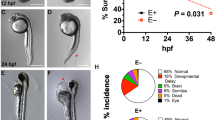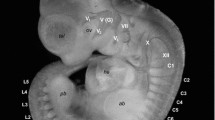Summary
The effect of excess vitamin A on the closure of the neural tube in mouse embryos was examined with light microscopy, transmission and scanning electronmicroscopy. The embryos were treated with the vitamin just before closure of the brain vesicles and examined during the following 24 h, a period during which under normal conditions the brain completely closes.
At 18–24 h after treatment the external features of the treated specimens began to differ from those of the controls. In the treated embryos the neural walls folded laterally and became widely separated, whereas those of the controls folded dorsomedially and fused in the midline. Histologically, the first difference between treated and control embryos was noted at two hours after treatment, when large intercellular spaces appeared between the neuroepithelial cells of the treated embryos. These spaces were mainly present between the apical ends of the wedge-shaped neuroepithelial cells. This accumulation of intercellular spaces interfered with the normal morphogenetic movement of the neural walls, which remained convex instead of becoming concave. This convex bending resulted in non-closure of the neural tube.
In addition to the appearance of large intercellular spaces some neuroepithelial cells as well as some mesenchymal, endothelial, and surface ectoderm cells showed swelling and degeneration as a result of the vitamin A treatment. This cell degeneration probably contributes to failure of the neural tube to close due to loss of cohesion at the luminal surface and the lack of mesenchymal support needed for the elevation of the neural walls. However, the increase of intercellular spaces at the apical side of the neuroepithelium is in all probability the major cause for the failure of the neural tube to close.
Similar content being viewed by others
References
Carter SB (1967) Effects of cytochalasins on mammalian cells. Nature 213, 261–264
Daniel MR, Dingle JT, Glauert AM, Lucy JA (1966) The action of excess vitamin A alcohol on the fine structure of rat dermal fibroblasts. J Cell Biol 30:465–475
Geelen JAG (1972) The localization of vitamin A in the pregnant rat by means of fluorescence microscopy. Teratology 6:19–26
Geelen JAG (1972) Vitamin A-induced anomalies in young rat embryos. Acta Morph Neerl-Scand 11:233–240
Geelen JAG (1979) Hypervitaminosis A induced teratogenesis. Critical Reviews in Toxicology. CRC Press, West Palm Beach 6:351–375
Geelen JAG, Langman J (1977) Closure of the neural tube in the cephalic region of the mouse embryo. Anat Rec 189:625–640
Geelen JAG, Langman J (1979) Ultrastructural observations on closure of the neural tube in the mouse. anat Embryol 156:73–88
Giroud A (1960) Causes and morphogenesis of anencephaly. In: GEW Wolstenholme and CM O'Connor (eds) Little Brown and Co, Boston USA CIBA-foundation symposium in Congenital Malformations
Giroud A, Delmas A, Martinet M (1959) Etude morphogénétique sur des embryons anencéphales. Arch Anat Histol Embryol 42:203–230
Hinds JW, Ruffet TL (1971) Cell proliferation in the neural tube: An electronmicroscopic and Golgi analysis of the mouse cerebral vesicle. Z Zellforsch 115:226–264
Jélinek R, Friebová Z (1966) Influence of mitotic activity on neurulation movements. Nature 209:822–823
Kalter H (1968) Teratology of the central nervous system. Univ of Chicago Press, Chicago
Karfunkel P (1972) The activity of microtubules and microfilaments in neurulation in the chick. J Exp Zool 181:289–302
Karfunkel P (1973) The mechanism of neural tube formation. Int Rev Cytol 38:245–271
Karnovsky MJ (1965) A formaldehyde-glutaraldehyde fixative of high osmolarity for use in electron-microscopy. J Cell Biol 27:137A-138A
Kochhar DM (1976) Transplacental passage of label after administration of 3H-retinoic acid (vitamin A acid) to pregnant mice. Teratology 14:53–64
Langman J, Welch GW (1967) Excess vitamin A and the development of the cerebral cortex. J Comp Neur 131:15–26
Langman J, Guerrant R, Freeman B (1966) Behavior of neuroepithelial cells during closure of the neural tube. J Comp Neur 127:399–412
Lee HY (1976) Inhibition of neurulation and interkinetic nuclear migration by concanavalin A in explanted early chick embryos. Dev Biol 48:392–399
Lee HY, Kalmus GW (1976) Effects of cytochalasin B on the morphogenesis of explanted early chick embryos. Growth 40:153–162
Lee HY, Nagele RG, Kalmus GW (1976) Further studies on neural tube defects caused by concanavalin A in early chick embryos. Experientia 32:1050–1052
Lemire RJ, Beckwith JB, Warkany J (1978) Anencephaly. Raven Press, New York
Lucy JA, Dingle JT (1964) Fat-soluble vitamins and biological membranes. Nature 204:156–160
Marin-Padilla M (1966) Mesodermal alterations induced by hypervitaminosis A. J Embryol Exp Morph 15:261–269
Morriss GM (1973) The ultrastructural effects of excess maternal vitamin A on the primitive streak stage rat embryo. J Embryol Exp Morph 30:219–242
Theiler K (1972) The house mouse. Development and normal stages from fertilization to four weeks of age. Springer Verlag, Berlin-Heidelberg
Theodosis DT, Fraser F (1978) Early changes in the mouse neuroepithelium preceeding exencephaly induced by hypervitaminosis. A. Teratology 18:219–232
Waterman RE (1976) Topographical changes along the neural fold associated with neurulation in the hamster and mouse. Am J Anat 146:151–172
Author information
Authors and Affiliations
Rights and permissions
About this article
Cite this article
Geelen, J.A.G., Langman, J. & Lowdon, J.D. The influence of excess vitamin A on neural tube closure in the mouse embryo. Anat Embryol 159, 223–234 (1980). https://doi.org/10.1007/BF00304980
Accepted:
Issue Date:
DOI: https://doi.org/10.1007/BF00304980




